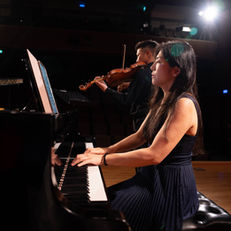LIN Kaiyu 林楷育
A LITTLE BIT
ABOUT
FIELD RESEARCH
With a foundation in rigorous physical science research,
Kai-Yu explores quantum entanglement and ultrafast optics, developing femtosecond laser systems to probe molecular dynamics. She also collaborates with scientists to create performative artworks that embody and express complex scientific processes.
Collaboration with Theoretical Astrophysics Lab – Star Formation (2023-ongoing)
本計畫源自研究恆星形成與太陽系早期演化的天文學家李悅寧與物理學研究者/當代舞蹈創作者林楷育的合作與進駐
From 2023–2024, we collaborated with a theoretical astrophysicist whose research focuses on the physics of star formation. The project began with a live public dialogue held at an active astronomical observatory, where we explored the intersection of scientific imagination and embodied knowledge.
Over the following year, we continued the exchange through shared studio sessions, developing a choreographic response to astrophysical concepts such as gravitational collapse, interstellar turbulence, and proto-stellar evolution. The collaboration culminated in a performance work that translated complex stellar dynamics into gesture, rhythm, and spatial composition—rendering the invisible forces of the cosmos temporarily perceptible through the moving body.

Research Residency with Gravitational Wave Observatory and Quantum Optics Lab (2023–2025)
From 2023 to 2024, I undertook a research-based residency with the Gravitational Wave Observatory, collaborating with artists and their scientific partners from various Taiwan-based research laboratories, such as the Quantum Optics Lab. Together, we explored the aesthetics of gravitational waves and black hole mergers through the lenses of quantum light and interferometry. During this time, I simultaneously worked on my creative projects while also participating in the measurement of gravitational wave data. Through ongoing discussions with scientists and access to experimental data, I developed a body of work that explored how the detection of gravitational waves could be translated into movement, sound, and spatial experiences. The residency culminated in a multimedia exhibition at the National Museum of Natural Science, followed by a performance that translated gravitational wave data into choreographic form.
.jpg)
Ultrafast Laser Research and Development (2015-2020)
Kai-Yu focuses her research on demonstrating novel techniques for generating ultrashort femtosecond pulse lasers and their applications in capturing the fastest dynamics in molecules. She found herself particularly engaged with projects involving the build-up of an ultrafast fiber laser system. Her current research centers on the development of a high-power femtosecond fiber Chirped-Pulse Amplification (CPA) system.

Laboratory Resonances :: Listening to the infrastructures of scientific knowledge
feat. Torcal
We’ve formed a team of young physicists, sound artists, and performing artists to embark on Laboratory Resonances, a sound research project exploring the acoustic landscapes of scientific infrastructures—where silence is designed, and noise becomes data.
Through field recordings inside active research environments—including rooftop antenna decks, nitrogen cooling tanks, computer clusters, and quantum electronics labs—we listen not only to the sounds of machines but to the epistemological systems they sustain. Each location becomes a sonic portrait of scientific presence: the hum of helium compressors, superconducting transitions, vibrating floors, and the pulse of computation.
Part poetic document, part acoustic archive, Laboratory Resonances positions listening as a method to access the invisible infrastructures of scientific labor—revealing their rhythms, textures, and the strange musicality of precision itself.
Residency at KEK|高エネルギー加速器研究機構, High Energy Accelerator Research Organization – Belle II (2015)
科學研究工作:日本高能物理加速器研究機構(KEK) Belle-II 計畫-於中央飄移室偵測器參與研究工作
During my two-month residency at KEK in Tsukuba, Japan, we participated in the Belle II experiment, contributing to the development of the Central Drift Chamber (CDC) detector. Immersed in the collaborative research environment, we engaged with international scientists and engineers, gaining hands-on experience in high-energy particle detection technologies and deepening our understanding of experimental particle physics.

Quantum Optics
which is focusing on Quantum Physics: generation of quantum noise squeezed states.
[Wave-particle duality 波粒二象性]
2020-ongoing

Ultrafast pulse laser - Chirped Pulse amplification system
Figure. The CPA technique revolutionized laser technology. It enabled the emission of very intense, short pulses of light using an intricate method to avoid the risk of destroying the amplifying material. Instead of amplifying the light pulse directly, it is first stretched in time, reducing its peak power. Then the pulse is amplified and when it is compressed more light is collected in the same place – the light pulse becomes extremely intense.
[1] D. Strickland and G. Mourou, Compression of amplified chirped optical pulses, Opt. Commun. 56, 219 (1985).
Latest Publications
"The Gravity Realm"
@ 國立自然科學博物館(台中科博館), National Museum of Natural Science, Taichung, June 14, 2023 - April 2024
@ LVKmeeting@Toyama poster session - Kai-Yu Lin
, Kamioka Gravitational wave detector, Large-scale Cryogenic Gravitational wave Telescope, 2023
—[Large-scale Cryogenic Gravitational Wave Telescope - KAGRA—


















